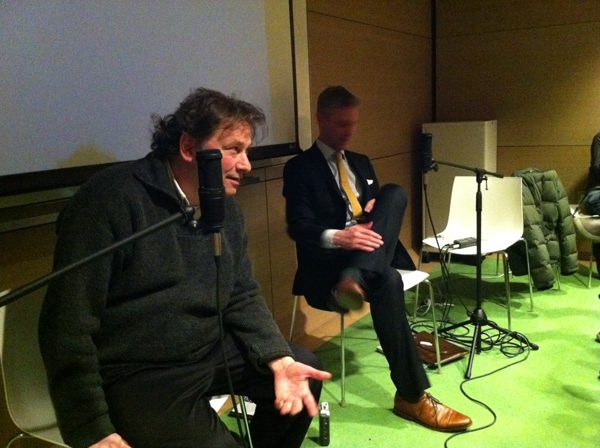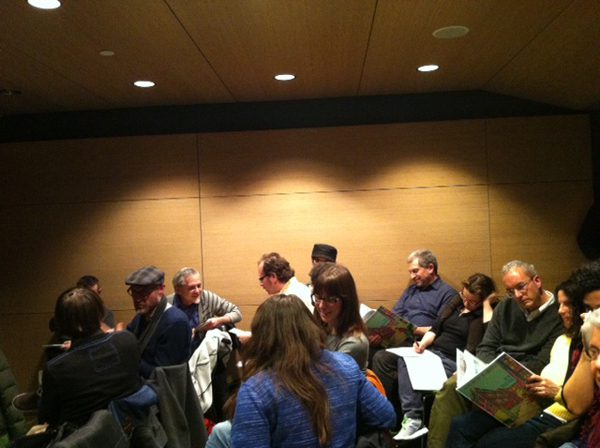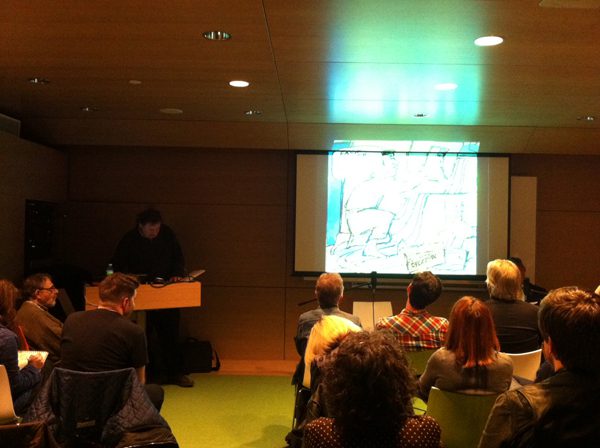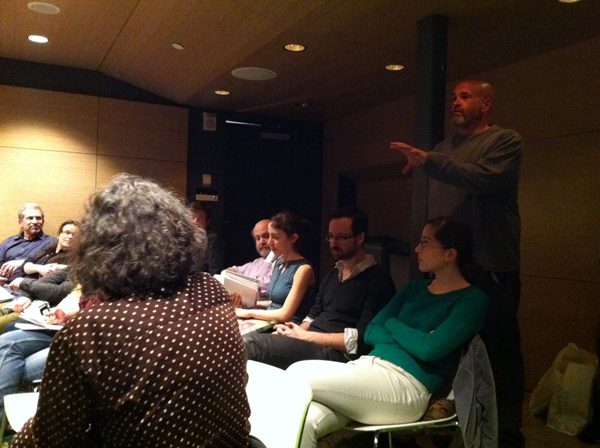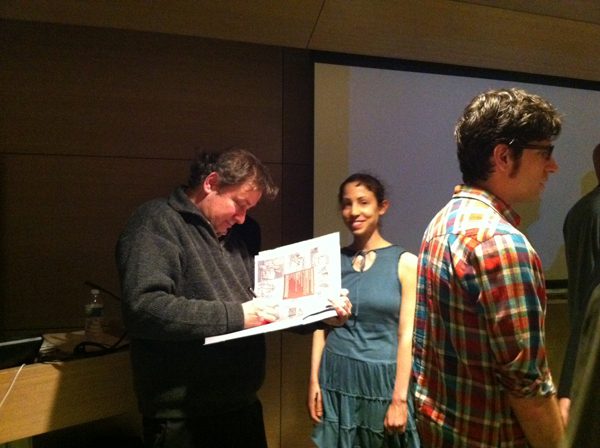The New York Comics & Picture-Story Symposium is a weekly forum for discussing the tradition and future of text/image work. Open to the public, it meets Monday nights 7-9 pm EST in New York City. Presentations vary weekly and include everything from historical topics and technical demonstrations to creators presenting their work. Check out upcoming meetings here.
The 38th Symposium meeting also doubled as a live recording session of the Virtual Memories Show, a podcast about books and life, produced by Gil Roth. On Monday night, Roth interviewed celebrated cartoonist Ben Katchor to a packed room at the New School. Every seat was filled and still more guests filed in, opting to stand in the back or sit on the floor. There were quite a few familiar faces in the audience, including Seymour Chwast, Richard McGuire, Robert Sikoryak, Tom Spurgeon, and Bill Kartalopoulos.
If you are on the mailing list for the NY Comics and Picture-Story Symposium, then you have been getting weekly emails from Ben Katchor announcing upcoming Symposium presenters. On Monday, April 1st, Symposium attendees had the treat of hearing Ben Katchor himself, the man behind the mailing list, speak about his own work for the first time since the meetings began nearly a year ago.
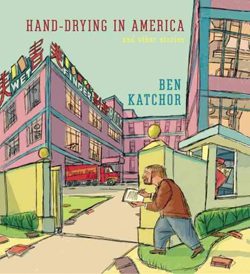 Katchor began by punctuating the evening with readings from his newest book, Hand-Drying in America (Pantheon), a compilation of his weekly comic strip in Metropolis Magazine that he has done since 1998. Asked by Roth about his approach to a weekly strip, Katchor described his view of stories as somehow architectural – there is a certain geometry and mathematics in how he breaks down a narrative. Rather than being confining, he sees an eight-panel strip as “eight chances to make an argument.”
Katchor began by punctuating the evening with readings from his newest book, Hand-Drying in America (Pantheon), a compilation of his weekly comic strip in Metropolis Magazine that he has done since 1998. Asked by Roth about his approach to a weekly strip, Katchor described his view of stories as somehow architectural – there is a certain geometry and mathematics in how he breaks down a narrative. Rather than being confining, he sees an eight-panel strip as “eight chances to make an argument.”
In the two-hour session, Katchor talked with Roth about his process and influences, his approach to weekly comic strips, views on publishing, and New York as an urban milieu. The conversation was meandering, entertaining, quietly revelatory, and full of Katchor’s signature wry wit and singular insight.
Every conversation with Katchor is a journey that takes you somewhere unexpected. As he put it himself, “I’m not out in the street breaking windows. I prefer to make comics about people breaking windows.”
Without recapping too much of the interview, which you can listen to yourself soon, let me just say that it is well worth tuning in to. The podcast recording is due to come out the week of April 15. Sign up on the website to receive a notification when the interview is released.
Here are some highlights:
On Process
During the interview, Katchor talked about drawing digitally, which he hasn’t always done. He started drawing on a Cintiq tablet about a year ago and by doing so, omitted the step in the process where a physical drawing is converted into a digital file. Katchor prefers drawing “directly” as a “more immediate” experience. He has little interest in the assembly-line, commercial process of making comics and is unsentimental about paper and ink. After all, he argued, “paper factories are horrible places and ink is carcinogenic.” Because he draws for reproduction, having a physical artifact is not the point for him. He described having a lot of drawings on paper, but not actually doing anything with them.
Comics as a Popular Art Form
One of the themes that emerged from the evening was his belief in comics as a popular art form that should be made widely available. One audience member asked a thoughtful question about the issue of access in comics, whether online or in print, pointing out that books can be cost-prohibitive and that internet access is not universal.
In response, Katchor reflected on the heyday of free newspapers, which he considered to be his “ideal venue” because it was free to anyone who wanted it. Even the tabloid design of newspapers appealed to him, “the crummier, the better,” explaining that he liked the socioeconomic aesthetic of it, which was essentially “cheap and disposable.” He acknowledged, however, that the venues for comics distribution are changing fast and that what worked for him may not be viable for young cartoonists today.
On New York City
Katchor’s work is often described as “nostalgic” and “melancholy,” an assumption he flatly refuted during the lively Q&A session. A lifelong New Yorker, he has always been aware that he lives in a city with history, but he doesn’t romanticize the past. He insisted that “it’s not nostalgia” for a bygone era. Rather, he wants “something new to happen.” In his estimation, the idea of nostalgia is as boring and ubiquitous as the Starbucks and conglomerate chains that pepper urban landscapes today.
Whether he finds the current landscape boring or not, he continues to pay close attention to the zeitgeist — and chronicling his view of it for the rest of us. For him, making comics is an iterative process that involves a lot of research, observation, and reading histories as inspiration for his strips. The medium, he argues, lends itself well to the telling of complex narratives that can challenge readers and “not be boring.”
As for the 38th meeting of the NY Comics Symposium, it was the farthest thing from boring.
If you missed it, be sure to check out Gil Roth’s podcast when it comes out.
***
CONNIE SUN is an Asian-American cartoonist from California, currently living in New York City. She works in higher education and draws a daily web comic strip at conniewonnie.com, Monday through Friday. You can follow her on Twitter or Facebook.

